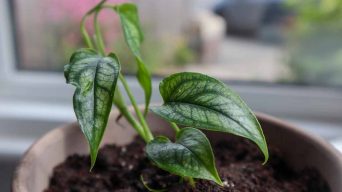Monstera plants should not be root bound as it hinders their growth and access to nutrients and water. They need to be repotted every two years or when roots come out of the drainage holes. Neglecting to repot can cause stunted growth, yellowing leaves, and root rot. Proper pot and potting mix are crucial.
Monstera plants, commonly known as the swiss cheese plant, are popular indoor plants with their distinctive leaves and easy-care nature.
But did you know that, when it comes to Monsteras, the root system is just as important as its foliage?
Knowing how to care for your plant’s roots can make a big difference in its overall health and beauty.
Here we’ll explore whether or not Monsteras like being root bound and the importance of repotting them when needed.
We’ll also provide tips on how to tell if your Monstera needs a new pot, so you can keep it looking healthy and beautiful.
What is Root Bound?
Root bound is when a Monstera plant’s roots have outgrown its container, and there is no longer enough space for them to grow.
The roots start to wrap around the inside of the pot, creating a tangled mess that can prevent the plant from accessing the nutrients and water it needs to thrive.
Plants become root bound when they are left in the same container for too long, and the roots have nowhere else to go.
As the roots continue to grow, they eventually hit the sides of the pot and start to circle around the base, forming a dense and tangled root system.
Now, you might be wondering, what are the negative effects of being root bound on plants? Well, there are a few that you should be aware of.
Firstly, root bound plants are more susceptible to pests and diseases. The cramped conditions can create a breeding ground for harmful bacteria and fungi, which can quickly spread and cause damage to the plant.
Secondly, root bound plants may struggle to access the nutrients and water they need to grow.
The tightly packed roots can prevent water and nutrients from penetrating the soil, which can lead to stunted growth, yellowing leaves, and even death in severe cases.
Do Monstera Plants Like to Be Root Bound?
Now, let’s address the question of whether Monstera plants like to be root bound.
The short answer is no; Monstera plants do not prefer to be root bound. While these plants can tolerate being root bound for a short period, it’s not ideal for their long-term growth and health.
When a plant is root bound, its roots have nowhere to go, which can lead to stunted growth, root rot, and nutrient deficiencies.
The negative effects of root bound on Monstera plants can manifest in a variety of ways.
The most obvious sign of a root bound Monstera plant is that it will outgrow its pot, with its roots becoming tightly coiled around the base of the pot.
This can cause the plant to become top-heavy and unstable, with a higher risk of falling over.
In addition, root-bound plants are more prone to pest infestations, as tightly packed roots can create a hospitable environment for insects.
Another issue with root-bound Monstera plants is that they are more susceptible to nutrient deficiencies.
When a plant’s roots are restricted, they cannot absorb the nutrients they need from the potting soil.
This can lead to stunted growth, yellowing leaves, and a general decline in health. In severe cases, a root-bound Monstera plant may die.
Monstera Plant’s Growth Habits
To understand whether Monstera plants prefer to be root bound, it’s essential to understand their growth habits.
Monstera plants are native to tropical rainforests, where they grow as epiphytes on trees, using their aerial roots to anchor themselves to the bark.
In the wild, these plants can grow up to 30 feet tall and have leaves over two feet in diameter.
In a domestic setting, Monstera plants usually grow to around six feet in height and have leaves that are around 12 inches in diameter.
The Ideal Pot Size for a Monstera Plant
The ideal pot size for a Monstera plant depends on the size of the plant and the growth rate.
These plants grow best in loose, well-draining soil, which allows air to circulate around the roots. If the potting soil is too compact, the roots can become waterlogged, which can lead to Monstera root rot.
A pot that is too small can restrict the growth of the plant, causing it to become stunted. A pot that is too large can cause the soil to retain too much moisture, leading to overwatering.
So, what is the ideal pot size for a Monstera plant? Generally, a pot that is one size larger than the current one is suitable for repotting.
For example, if your Monstera plant is in a six-inch pot, a seven or eight-inch pot would be the right size for repotting.
It’s also essential to ensure that the pot has drainage holes at the bottom to prevent water from accumulating in the soil mix.
Signs of a Root Bound Monstera Plant
The first step in determining whether your Monstera plant needs repotting is to look for signs of a root bound plant.
A root-bound plant means that the roots have grown too large for the pot they’re in, causing them to become tangled and compacted.
This can lead to a host of problems, including stunted growth and nutrient deficiencies.
1. Roots Coming Out of the Drainage Holes
One of the most obvious signs of a root-bound Monstera plant is roots coming out of the drainage holes.
If you notice this, it’s a clear indication that the roots have grown too large for the pot.
2. Roots Circling at the Bottom of the Pot
Another sign of a root-bound Monstera plant is when its roots circle around the bottom of the pot.
This can impede the growth of new roots and limit the uptake of nutrients, leading to stunted growth and yellowing leaves.
3. Slow Growth
Another sign to look out for is slow growth.
If your Monstera plant isn’t growing as quickly as it used to, it could be a sign that it needs more space to expand its roots and access more nutrients.
4. Yellowing Leaves
Yellowing leaves can also be a sign of a root-bound Monstera plant.
When the roots are cramped, they can’t absorb nutrients efficiently, which can cause the leaves to turn yellow.
If you notice your Monstera leaves starting to yellow, it may be time to repot it.
5. Pot Is Too Small for the Plant
If the pot your Monstera plant is in seems too small for the plant, it’s a good indication that it needs repotting.
As the plant grows, it will need more space for its roots to expand, and a larger pot will provide the necessary room for growth.
6. Wilting or Drooping Leaves
If your Monstera plant’s leaves are drooping or wilting, it could be a sign of root rot, which can occur when the roots are too compacted in a small pot.
Wilting leaves can also be a sign of overwatering. It’s important to check the soil for moisture before repotting.
How to Fix a Root Bound Monstera Plant
A root-bound Monstera plant can cause all sorts of problems, from stunted growth to poor nutrient uptake.
Fortunately, with a little bit of know-how, you can fix a root-bound Monstera plant and keep it thriving for years to come.
Step 1: Assess the Damage
The first step is to assess the damage.
Take a close look at the root system and make sure it doesn’t have any signs of disease or damage. If there are any diseased roots, remove them carefully with a pair of sterilized scissors.
Step 2: Choose the Right Pot
Choosing the right pot for your Monstera plant is essential.
You want a pot that’s big enough to accommodate the plant’s roots but not so big that it becomes waterlogged.
Look for a pot that’s about one size larger than your current pot.
When it comes to material, there are plenty of options out there. You can choose from plastic, ceramic, or even terracotta.
Just make sure that the pot you choose has adequate drainage holes.
Step 3: Prepare the Potting Mix
Once you’ve chosen the right pot, it’s time to prepare the potting mix.
You’ll need a potting mix that drains well and retains moisture without becoming waterlogged. A combination of perlite, peat moss, and compost is usually a good option.
Step 3: Repot the Plant
When it comes to repotting your Monstera plant, the best time to do it is in the spring or early summer when the plant is actively growing. This will give it the best chance to adjust to its new environment and begin to thrive.
Before repotting, make sure you have the right size pot and fresh potting soil ready to go.
It’s also important to water your Monstera plant a day or two before repotting to ensure that the roots are hydrated and healthy.
To repot your Monstera plant:
- Gently remove it from its old pot and shake off any loose soil. If the roots are tightly bound, use your fingers or a clean knife to loosen them slightly.
- Place the plant in its new pot, making sure that the top of the root ball is level with the top of the soil.
- Fill in any gaps with fresh soil, being careful not to compact it too tightly.
- Water the plant thoroughly, making sure that the water drains out of the bottom of the pot.
- Finally, place the plant in a bright, indirect light and let it adjust to its new environment.
Step 4: Care for Your Repotted Monstera Plant
Caring for a repotted Monstera plant requires a little bit of finesse.
First and foremost, make sure that you’re watering the plant properly.
Overwatering can lead to root rot, while underwatering can cause the Monstera plant to wilt and die.
To water your Monstera plant, make sure that the top inch of the soil is dry before watering.
Then, water the plant thoroughly, allowing excess water to drain away from the pot.
You may also want to consider fertilizing your Monstera plant every 2-3 weeks during the growing season.
Another important aspect of caring for a repotted Monstera plant is ensuring that it has adequate light.
Monstera plants thrive in bright, indirect light, so make sure that your plant is placed in a well-lit area of your home.
Final Thoughts
While Monsteras can tolerate being slightly root-bound, it is not ideal for their growth and health in the long term.
Monsteras need enough space for their roots to spread and access nutrients and water, so they should be repotted every two years or so.
When the roots start to come out of the drainage holes or the plant becomes too big for its current pot, it is time to repot the Monstera.
Neglecting to repot a Monstera can lead to stunted growth, yellowing leaves, and even root rot.
It is crucial to choose a pot with proper drainage holes and a suitable potting mix when repotting a Monstera.
Once the plant is in its new pot, provide it with adequate light and water, as well as regular fertilizing during the growing season.
By providing your Monstera with proper care, you can ensure that it continues to thrive for many years.







